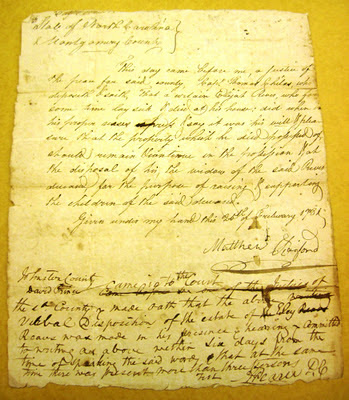Henry Reeves, Sr. is presumed to be the immigrant and first of this particular Reeves lineage to be found in the American colonies. He was granted 600 acres on Tigner's Creek on the south side of the Rappahannock River in Old Rappahannock County, Virginia (now Essex County), on January 1, 1666. In 1672, he received a land grant of 150 acres in Nansemond County. He doesn't appear to have remained long in Nansemond, returning to Old Rappahannock County where he died on April 6, 1687, naming all of his children in his
1686 will.
By 1753 when Henry's grandson George Reeves (son of Henry Reeves, Jr.) died, he named various nieces and nephews as legatees. After this
1753 will, there are few probate records for this family to aide in clearly identifying future generations. Four sons of Thomas Reeves, Sr. were mentioned in George's will, Henry, George, Thomas Jr. and John. Of those four, further records can only be found of Thomas, Jr. and John.
 George Reeves
George Reeves of Grayson County, Virginia is noted in numerous family trees and websites as being the son of
Thomas Reeves of Spotsylvania County, son of Henry Reeves, Jr. Since the DNA of several descendants of George Reeves is a match to members of my own Reeves’ family, I have been searching for some documentation to either prove or disprove these assertions. Three descendants of George Reeves have been placed in Group 6 of the Reeves’ DNA Project along with three descendants of William Reeves of Wake County, North Carolina.
Conversely, a participant in DNA Group 9 which is a completely different lineage, has a pedigree that extends to John Reeves, born circa 1730 in Spotsylvania County, the son of Thomas Reeves, Sr. If the research in this pedigree is accurate which it appears to be, DNA Group 9 is the lineage that descends from Henry Reeves of Essex County.
The three descendants of George Reeves of Grayson County in DNA Group 6 match 34 to 36 markers out of 37 with descendants of
William Reeves of Wake County, North Carolina. It is worthy of note that there was a George Reeves living in the Orange/Johnston County area (became Wake in 1771) in close proximity to William Reeves and associated with him in various deeds. Also living in this area and associated with William and George Reeves was Richard Burton, father-in-law of George.
Both Richard Burton and George Reeves sold their property in Johnston County around 1765 which coincides with their appearance in the New River area in 1767. Additionally, a Johnston County court order of July 15, 1766 records Timothy Shaw replacing George Reeves as overseer of the road which was probably the result of George Reeves’ removal from the area.
When documents with signatures by George Reeves of Grayson County or his sons can be found, their surnames are written "Reves" just as William Reeves of Wake County and his sons. This was not the case in the Henry Reeves family.
John Reeves of the Group 9 lineage was named as a legatee in the 1753 will of his uncle George Reeves in Spotsylvania County, Virginia. He is recorded in the land records of Augusta County along with his brother, Thomas Reeves, Jr. from the 1760’s to the 1780’s. After the formation of Rockingham County, he is on the tax lists there in 1792 and his death in 1799 was recorded in Augusta County.
Although George Reeves also named a nephew George, son of his brother Thomas Reeves, in his will, nothing can be found to support a conclusion that George Reeves of Grayson County is that person. From the available extant records and the results of DNA testing, George Reeves of Grayson County is of another Reeves' lineage, not that of Henry Reeves of Essex County.
Posts in this Blog with the latest research and information concerning the family of Henry Reeves of Essex, Virginia
Essex County's Henry Reeves Family
Thomas Reeves of Woodford County, Kentucky
Up to date
listing of the descendants of Henry Reeves, Sr.


















